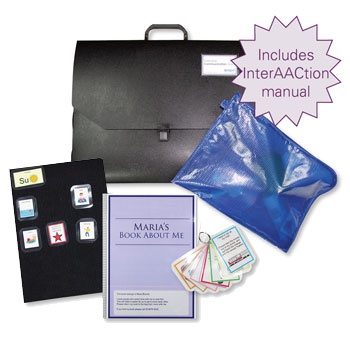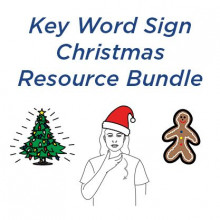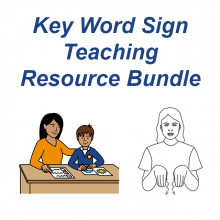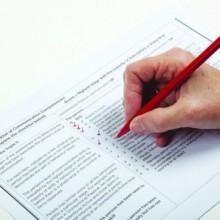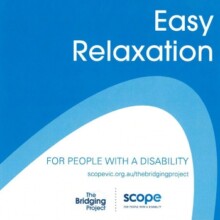Everyday Communication Aids
$1,089.00 inc. GST
Description
Everyday Communication Aids is a kit of example communication aids and resource materials. This kit is ideal for training organisations and universities who teach speech pathology, disability, aged care and other sectors that work with people with complex communication needs – people with little or no speech.
The communication aids and resources included in this kit are highlighted in the InterAACtion Manual (which is also included in this kit).
We also include a free copy of the InterAACtion DVD which shows real life scenarios and strategies to support adults with communication difficulties.
Features one example aid of each of the following:
– Book about me:
- A ‘Book about me’ may be suitable for people who can understand photos or pictures but is most useful for support workers.
- It contains current, relevant information about a person’s needs and abilities.
- It can provide support people with information about a person’s daily routine and how to support them consistently with activities of daily living e.g. during mealtimes.
- It may also provide communication partners with information on the person’s likes and dislikes.
– Chores chart:
- Chores charts are suitable for people who understand photos, pictures or line drawings.
- They use these symbols or photos to display the daily or weekly routine tasks within the home or work environment.
- Photos of the people responsible for these tasks are also used to give a visual reminder about what their jobs are, e.g. unpack the dishwasher, feed the fish, sweep the floor.
- They can also be referred to as a jobs board or duty roster.
– Communication board:
- Communication boards are made specifically to suit the person’s individual needs.
- Depending on their level of understanding, photos or line drawings can be used to represent people, places and objects.
- Usually presented in a grid.
– Community request cards:
- May be suitable for people who want to request items and services in the community.
- They can be represented in photo, picture or object form.
- They include information about what the person wants e.g. ‘white coffee with black sugar’, and what the communication partner should do, e.g. ‘put the change back in my wallet’.
- A number of different cards can be developed for different situations in the person’s life such as going bowling, eating out or going to the movies.
- Also called community passports.
– Object Symbols:
- Object symbols (tangible symbols) may be suitable for people who can understand that whole or parts of real objects can be used to represent an activity.
- They can represent things, activities or events and can be used to help the person understand what is going to happen or to make a simple choice.
- Using a real or partial object is the simplest and most concrete way of representing events and activities and therefore a good starting point for people with learning disabilities.
- The objects selected look, feel or have something to do with the item or activity they represent.
– Picture-based timetable:
- Timetables may be useful for people who need visual supports in symbol form to display daily or weekly activities and events.
- They use pictures, photos or line drawings to show the sequence of activities in a day or a week.
- Storage and display can vary greatly depending on the needs of the individual you are working with and must be considered carefully before the timetable is produced.
– Picture-based shopping book:
- A picture based shopping list may be useful for people who need visual reminders about the items that they need to buy in picture or photo form.
- It uses photos, logos or pictures of the specific food items in various formats to develop a suitable shopping list that can be used in the home or day program.
– Who’s here today chart:
- Charts are a visual support that uses pictures, photos or words to display the whereabouts of different people.
- It is especially useful for places where people are coming and going on a daily basis.
- It prepares the person for who they should expect to see and any changes that may occur unexpectedly.
- These charts may also be referred to as a roll call or movement monitor.
– Yes/No wrist bands:
- A simple way to indicate yes or no.
- The individual wears adapted sweat bands on their left and right wrists.
- On the left band is sewn a line drawing for “no” and the word “no”.
- On the right band is sewn a line drawing for “yes” and the word “yes”.
- The person looks at or raises his or her hand in response to a yes/no question.
– And many more!
This kit comes in an easy to transport carry case with handle, to cart your communication aids from class to class. It also has a separate zip-lock case for the object symbols, which attach to the handle to keep everything together. The InterAACtion Manual and DVD will also be sent to you with this kit.
Please contact Scope’s Communication and Inclusion Resource Centre if you would like more information, or to check if this kit would be suitable for you.
Note: This product is made to order, please contact us for expected delivery date.
Email: circ@scopeaust.org.au
Phone: 03 9843 2000
BULK ORDER DISCOUNTS:
5% discount for orders of 10 units or more of the same item.
10% discount for orders of 20 units or more of the same item.
15% discount for orders of 30 units or more of the same item.
Postage
Items are shipped at no extra cost and by standard post unless the “Express Post” item is also added to your cart.
Australia Post advises that standard post is 5-7 business days.
